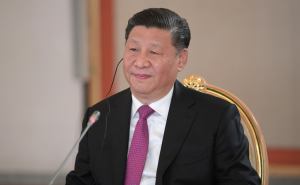By Deep Pal and Suchet Vir Singh
 Shortly after Indian Prime Minister Narendra Modi declared that “neither had China entered our territory, nor occupied our posts,” on June 19, in reference to the tragic incident in Eastern Ladakh’s Galwan Valley, China’s Ministry of Foreign Affairs released their version of events. China turned Modi’s statement around to accuse India of transgressing and trying to alter the status quo at the Line of Actual Control (LAC). Although clarifications came from the Prime Minister’s Office a day later, this swift round of China’s infamous “wolf-warrior diplomacy” allowed them to capture the narrative surrounding the clash at Galwan Valley.
Shortly after Indian Prime Minister Narendra Modi declared that “neither had China entered our territory, nor occupied our posts,” on June 19, in reference to the tragic incident in Eastern Ladakh’s Galwan Valley, China’s Ministry of Foreign Affairs released their version of events. China turned Modi’s statement around to accuse India of transgressing and trying to alter the status quo at the Line of Actual Control (LAC). Although clarifications came from the Prime Minister’s Office a day later, this swift round of China’s infamous “wolf-warrior diplomacy” allowed them to capture the narrative surrounding the clash at Galwan Valley.
However, changing ground realities with neighbors only represents a small part of a much larger and ambitious set of goals for China. Beyond territorial ambitions, Beijing wants to control how states interact. The latest such instance that provides Beijing with this opportunity is the recent U.S. withdrawal from the World Health Organization (WHO). For China, this is an opportunity to add to its heft in the international order and fulfil its ambitions of redesigning multilateral arrangements. It also means replacing the current U.S. endorsed “liberal rules-based order” with a model that benefits Beijing and fulfills its self-interests.
For this, Beijing has pushed the “hub-and-spoke model” as a means for China to become the nucleus of global governance. Ironically, first used by the United States in the early years after World War II, the model hinges on a series of bilateral agreements instead of multilateral institutions. China has already extensively applied this model in the Balkans, Central and Eastern Europe, and parts of Asia as part of its flagship foreign policy project, the Belt and Road Initiative (BRI).
In this grand infrastructure exercise, China aims to connect to the rest of the world through economic corridors over land and water. Since the BRI originates in China, it becomes the hub, while other countries act as spokes, connecting China to the world. The drawback inherent in such an arrangement is that the spokes are always dependent on — and in the shadow of — the hub, even to fulfill bilateral requirements between themselves. This essentially leads to a system that benefits only China. Funding is routed through China-dominated agencies, such as the Silk Road Fund, the China Development Bank, or the Asian Infrastructure and Investment Bank (AIIB). The hub-and-spoke, therefore, increases China’s influence and power by default and design.
China’s global health diplomacy under the Health Silk Road (HSR) during COVID-19 demonstrates the latest instance where it has applied this hub-and-spoke schema. Beijing has virtually taken over the WHO’s job, supplying medical equipment, expert advice, and allied services to more than 120 countries. The HSR follows the same structure, model of financing, and implementation as the BRI – with China as the hub, and the rest as spokes. China-controlled institutions like the AIIB have already been catalyzed to support countries during the pandemic.
In South Asia, as in other parts of the world, China is working with countries to update their public health infrastructure. As BRI partners, Bangladesh, Nepal, Pakistan, and Sri Lanka stand to benefit from Chinese expertise immediately. China is already providing them with medical equipment, expert advice from doctors, and even with infrastructure assistance, such as by building a makeshift hospital in Pakistan. In time, this can stretch to collaborations in biomedical technology or synthetic biology and even telemedicine.
Increasing dependence on China in newer spheres will raise its own set of challenges for these states. As with the rest of BRI, countries that embrace the HSR will, over time, become critically dependent on China for public health deliveries and capacities. Further, the strategic absence of a multilateral institutional framework in the hub-and-spoke will prevent these states from bilaterally interacting to mutually benefit each other, effectively enhancing their reliance on Beijing’s control. Maximizing strategic benefit through hedging, or the practice of avoiding close alignment with any single power, is something that smaller South Asian states excel in. However, this will now become more difficult.
Others in the neighborhood, most crucially India, have little in terms of immediate remedy. Collaborations with the so-called Quad-plus group of countries to synergize action against the virus will be necessary to continue beyond the pandemic and, hopefully, expand to other areas. At the same time projects such as those envisaged under the Japan-India Asia Africa Growth Corridor, or India’s own Indo-Pacific Oceans Initiative will also need to be revived. Moves such as inviting Australia to participate in Malabar naval exercise with Japan, India, and the United States, while also signing a defense agreement to use each other’s military bases will expand options for India.
If these don’t work, India may be forced to consider a future where it might have to acquiesce to becoming one amongst the many spokes to China’s hub. In such a scenario, as China’s clout rises, so will its belligerence: skirmishes like in Galwan Valley and transgressions at the LAC will become even more frequent. A lot would also depend on if and how the United States decides to overturn its decision of global retrenchment. In the meantime, however, China, with its first-mover advantage will attempt to firmly entrench itself as the “hub” in South Asia and beyond.
Deep Pal is a non-resident fellow at the National Bureau of Asian Research. He tweets @DeepPal_.
No comments:
Post a Comment